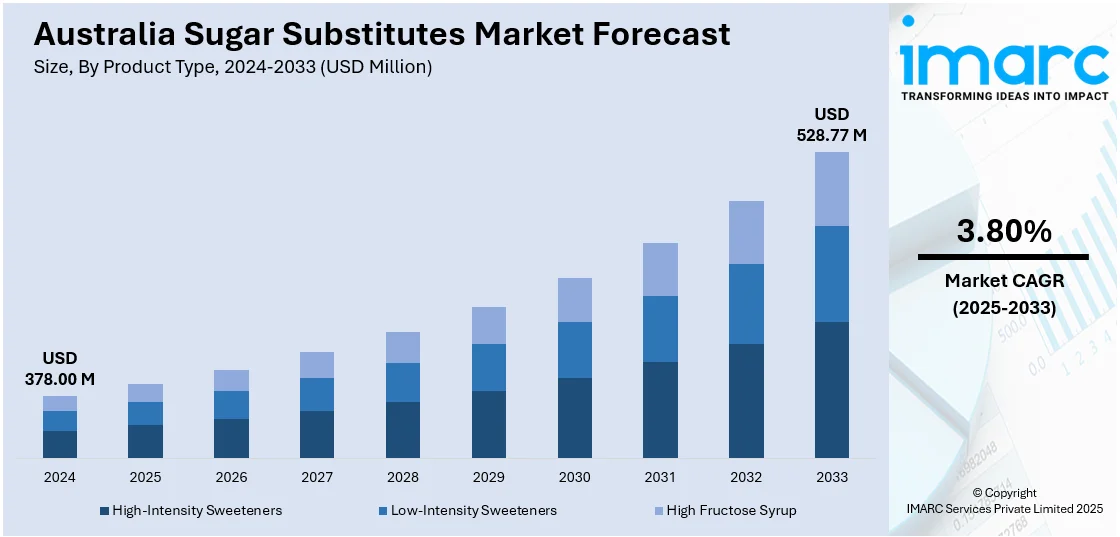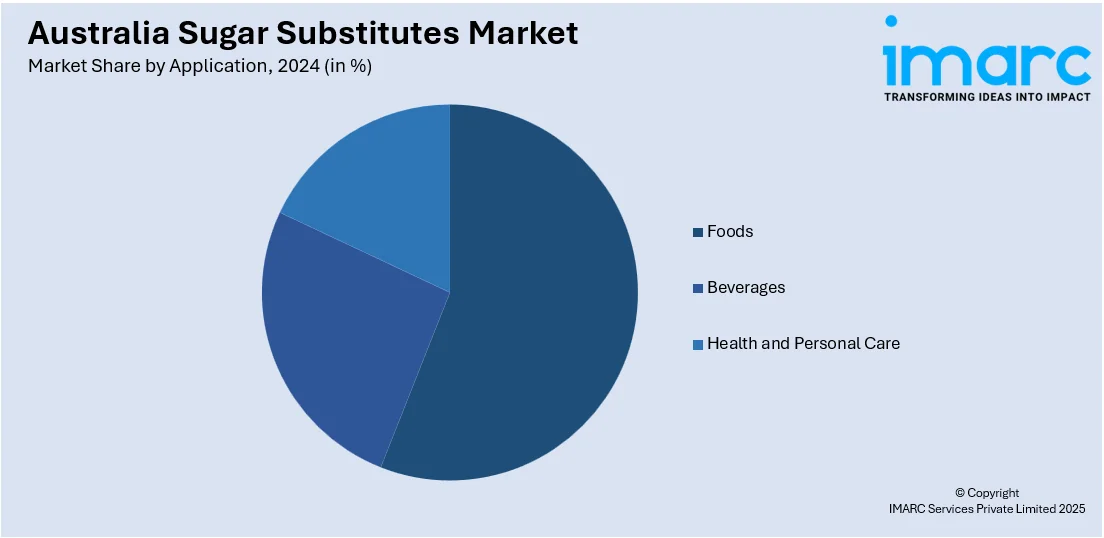
Australia Sugar Substitutes Market Size, Share, Trends and Forecast by Product Type, Application, Origin, and Region, 2025-2033
Australia Sugar Substitutes Market Overview:
The Australia sugar substitutes market size reached USD 378.00 Million in 2024. Looking forward, IMARC Group expects the market to reach USD 528.77 Million by 2033, exhibiting a growth rate (CAGR) of 3.80% during 2025-2033. The increasing health consciousness, rising rates of obesity and diabetes, growing demand for low-calorie and natural sweeteners, and growth in the food and beverage industry seeking healthier formulations are some of the major factors fueling the market share.
|
Report Attribute
|
Key Statistics
|
|---|---|
|
Base Year
|
2024 |
|
Forecast Years
|
2025-2033
|
|
Historical Years
|
2019-2024
|
| Market Size in 2024 | USD 378.00 Million |
| Market Forecast in 2033 | USD 528.77 Million |
| Market Growth Rate 2025-2033 | 3.80% |
Australia Sugar Substitutes Market Trends:
Rising Health Consciousness and Dietary Awareness
Australian consumers increasingly prioritize health and nutrition, leading to greater scrutiny of food labels and sugar content. Health problems linked with excessive sugar consumption have convinced people to switch to healthier ways of living. The demand for sugar substitutes has increased notably because people want low-calorie natural sweeteners such as stevia and monk fruit. Health-conscious customers choose products that lower their sugar intake without compromising food taste. This has led to a surge in reformulated products across categories such as soft drinks, yogurts, and snacks, which is creating a positive impact on the Australia sugar substitutes market outlook. Educational campaigns by health authorities and influencers have also reinforced this awareness, encouraging consumers to seek out alternatives that support wellness goals. As this trend continues, health consciousness remains a major factor propelling the sugar substitutes market in Australia.

To get more information on this market, Request Sample
Prevalence of Obesity and Diabetes
The rising prevalence of obesity and type 2 diabetes in Australia is a major factor driving the demand for sugar substitutes. According to national health data, more than 67% of Australian adults are overweight or obese, and approximately 5% live with diabetes. These health concerns have intensified the need for low-sugar or sugar-free dietary options, thus driving the Australia sugar substitutes market growth. Sugar substitutes offer a safe and effective way to reduce calorie intake and manage blood sugar levels without compromising sweetness. Consequently, they are being incorporated into more diabetic-friendly and weight-management products across the market. Healthcare professionals and nutritionists also advocate for reduced sugar consumption, further promoting the adoption of sugar alternatives. With chronic diseases continuing to impact a large portion of the population, the use of sugar substitutes in food and beverages is expected to rise steadily as part of broader health management strategies.
Innovation and Expansion of Sugar Substitute Options
The Australia sugar substitutes market share is increasing from ongoing innovation and the growing availability of alternative sweeteners. Advancements in food technology have made it possible to develop sweeteners that mimic the taste and texture of sugar more closely than ever before. Natural options like stevia and monk fruit, as well as sugar alcohols such as erythritol and xylitol, are being widely adopted in new product formulations. These innovations cater to a variety of dietary needs—low-carb, keto, diabetic-friendly, and vegan—broadening their market appeal. In addition, manufacturers are offering blends of sweeteners to enhance taste while maintaining health benefits. The expansion of sugar-free or reduced-sugar product lines in beverages, snacks, baked goods, and even condiments demonstrate the versatility and rising consumer preference for these alternatives. As innovation continues, sugar substitutes are becoming a mainstream ingredient in health-conscious food product development.
Australia Sugar Substitutes Market Segmentation:
IMARC Group provides an analysis of the key trends in each segment of the market, along with forecasts at the country and regional levels for 2025-2033. Our report has categorized the market based on product type, application, and origin.
Product Type Insights:
- High-Intensity Sweeteners
- Stevia
- Aspartame
- Cyclamate
- Sucralose
- Saccharin
- Others
- Low-Intensity Sweeteners
- D-Tagatose
- Sorbitol
- Maltitol
- Xylitol
- Mannitol
- Others
- High Fructose Syrup
The report has provided a detailed breakup and analysis of the market based on the product type. This includes high-intensity sweeteners (stevia, aspartame, cyclamate, sucralose, saccharin, and others) low-intensity sweeteners (d-tagatose, sorbitol, maltitol, xylitol, mannitol, and others) and high fructose syrup.
Application Insights:

- Foods
- Beverages
- Health and Personal Care
A detailed breakup and analysis of the market based on the application have also been provided in the report. This includes foods, beverages, and health and personal care.
Origin Insights:
- Artificial
- Natural
A detailed breakup and analysis of the market based on the origin have also been provided in the report. This includes artificial and natural.
Regional Insights:
- Australia Capital Territory & New South Wales
- Victoria & Tasmania
- Queensland
- Northern Territory & Southern Australia
- Western Australia
The report has also provided a comprehensive analysis of all the major regional markets, which include Australia Capital Territory & New South Wales, Victoria & Tasmania, Queensland, Northern Territory & Southern Australia, and Western Australia.
Competitive Landscape:
The market research report has also provided a comprehensive analysis of the competitive landscape. Competitive analysis such as market structure, key player positioning, top winning strategies, competitive dashboard, and company evaluation quadrant has been covered in the report. Also, detailed profiles of all major companies have been provided.
Australia Sugar Substitutes Market News:
- In November 2024, Samyang recently revealed that it had obtained FSANZ approval to market allulose as a safe food additive in Australia and New Zealand, making it the first company globally to secure Novel Food approval for allulose in these regions. Allulose is an uncommon sugar that has 70% of sucrose's sweetness and almost no calories.
Australia Sugar Substitutes Market Report Coverage:
| Report Features | Details |
|---|---|
| Base Year of the Analysis | 2024 |
| Historical Period | 2019-2024 |
| Forecast Period | 2025-2033 |
| Units | Million USD |
| Scope of the Report | Exploration of Historical Trends and Market Outlook, Industry Catalysts and Challenges, Segment-Wise Historical and Future Market Assessment:
|
| Product Types Covered |
|
| Applications Covered | Foods, Beverages, Health and Personal Care |
| Origins Covered | Artificial, Natural |
| Regions Covered | Australia Capital Territory & New South Wales, Victoria & Tasmania, Queensland, Northern Territory & Southern Australia, Western Australia |
| Customization Scope | 10% Free Customization |
| Post-Sale Analyst Support | 10-12 Weeks |
| Delivery Format | PDF and Excel through Email (We can also provide the editable version of the report in PPT/Word format on special request) |
Key Questions Answered in This Report:
- How has the Australia sugar substitutes market performed so far and how will it perform in the coming years?
- What is the breakup of the Australia sugar substitutes market on the basis of product type?
- What is the breakup of the Australia sugar substitutes market on the basis of application?
- What is the breakup of the Australia sugar substitutes market on the basis of origin?
- What is the breakup of the Australia sugar substitutes market on the basis of region?
- What are the various stages in the value chain of the Australia sugar substitutes market?
- What are the key driving factors and challenges in the Australia sugar substitutes market?
- What is the structure of the Australia sugar substitutes market and who are the key players?
- What is the degree of competition in the Australia sugar substitutes market?
Key Benefits for Stakeholders:
- IMARC’s industry report offers a comprehensive quantitative analysis of various market segments, historical and current market trends, market forecasts, and dynamics of the Australia sugar substitutes market from 2019-2033.
- The research report provides the latest information on the market drivers, challenges, and opportunities in the Australia sugar substitutes market.
- Porter's five forces analysis assist stakeholders in assessing the impact of new entrants, competitive rivalry, supplier power, buyer power, and the threat of substitution. It helps stakeholders to analyze the level of competition within the Australia sugar substitutes industry and its attractiveness.
- Competitive landscape allows stakeholders to understand their competitive environment and provides an insight into the current positions of key players in the market.
Need more help?
- Speak to our experienced analysts for insights on the current market scenarios.
- Include additional segments and countries to customize the report as per your requirement.
- Gain an unparalleled competitive advantage in your domain by understanding how to utilize the report and positively impacting your operations and revenue.
- For further assistance, please connect with our analysts.
 Request Customization
Request Customization
 Speak to an Analyst
Speak to an Analyst
 Request Brochure
Request Brochure
 Inquire Before Buying
Inquire Before Buying




.webp)




.webp)












